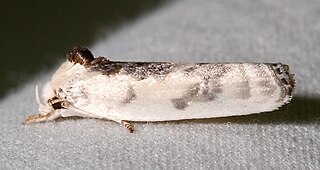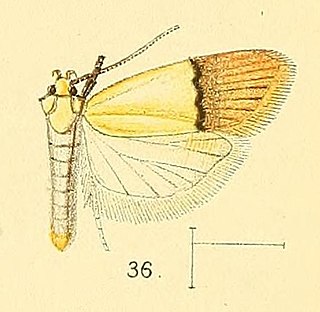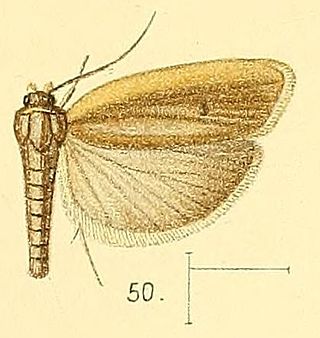
Aristotelia is a genus of moths in the family Gelechiidae. Well-known species are food plant specialists, and diverse hosts are used – Salicaceae, Solanaceae, Rosaceae, Fagaceae, Fabaceae, Asteraceae.

Brachmia is a genus of the twirler moth family (Gelechiidae). Among these, it is mostly placed in the subfamily Dichomeridinae.

Dichomeris is a genus of moths in the family Gelechiidae erected by Jacob Hübner in 1818.

Imma is a large genus of moths in the obtectomeran "micromoth" family Immidae. This is the type genus of its family. They are widespread in the tropics, with most species occurring between the Himalayas and the Oceanian region; the genus is furthermore plentiful in the Neotropics, but not very diverse in the Afrotropics.

Labdia is a genus of moths in the family Cosmopterigidae.

The Oecophorinae are the nominate subfamily of moths in the concealer moth family (Oecophoridae). They are part of the insufficiently studied superfamily Gelechioidea, and like their relatives, the circumscription of this taxon is disputed.

Oenochrominae is a subfamily of the moth family Geometridae.

Antaeotricha is a genus of moths. It is the largest genus in the subfamily Stenomatinae, numbering over 400 species in the Western Hemisphere.

Acrocercops is a genus of moths in the family Gracillariidae.

Choreutis is a moth genus. It belongs to the metalmark moths, and therein to subfamily Choreutinae. Of these, it is the type genus. The genus was described by Jacob Hübner in 1825.

Xyloryctidae is a family of moths contained within the superfamily Gelechioidea described by Edward Meyrick in 1890. Most genera are found in the Indo-Australian region. While many of these moths are tiny, some members of the family grow to a wingspan of up to 66 mm, making them giants among the micromoths.

Odites is a genus of moths in the family Depressariidae. Most species of this genus are found in Asia and in Africa.

Stenoma is a genus of moths. The type species is Stenoma litura, which was described by Philipp Christoph Zeller in 1839.
Athrypsiastis is a genus of moths of the family Xyloryctidae. The genus was erected by Edward Meyrick in 1910.
Athrypsiastis phaeoleuca is a moth in the family Xyloryctidae. It was described by Edward Meyrick in 1910. It is found on New Guinea.
Athrypsiastis salva is a moth in the family Xyloryctidae. It was described by Edward Meyrick in 1932. It is found in China.
Athrypsiastis symmetra is a moth in the family Xyloryctidae. It was described by Edward Meyrick in 1915. It is found on New Guinea.
Athrypsiastis chionodes is a moth in the family Xyloryctidae. It was described by Alexey Diakonoff in 1954. It is found in New Guinea.
Athrypsiastis delicata is a moth in the family Xyloryctidae. It was described by Alexey Diakonoff in 1954. It is found in New Guinea.











